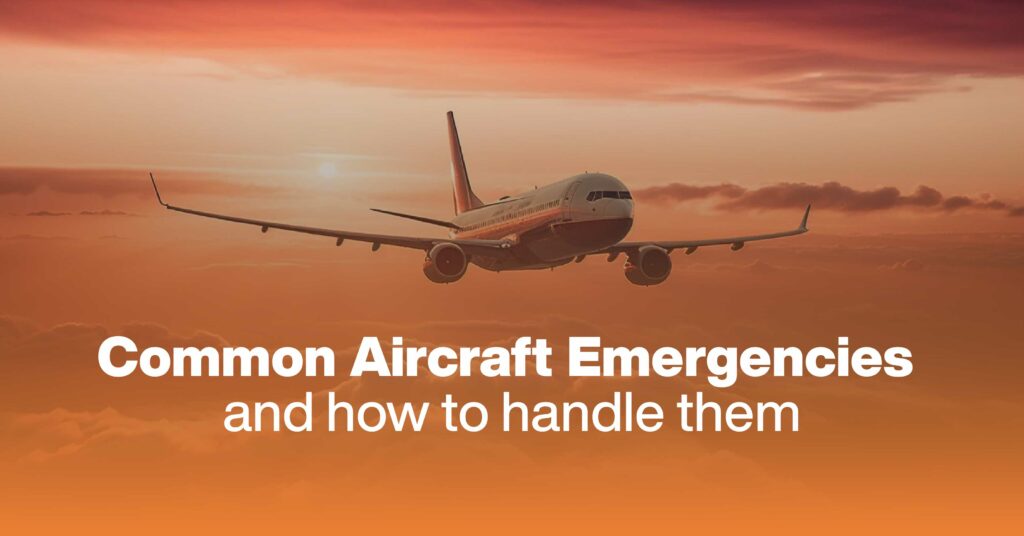Flying in an aircraft is generally a safe and reliable means of transportation. However, like any mode of transportation, emergencies can occur unexpectedly. It is important for passengers and crew members to understand the common types of aircraft emergencies and how to handle them. In this article, we will explore four types of common aircraft emergencies, the role of Garg Aviatons in handling these situations, and provide insights on how to ensure safety during these incidents.
Types Of Common Aircraft Emergencies
1. Engine Failure:
Engine failure is one of the most critical emergencies that can occur during a flight. It can be caused by various factors such as mechanical issues, fuel problems, or bird strikes. In the event of an engine failure, pilots are trained to follow specific protocols to ensure the safety of the aircraft and its passengers. These protocols usually involve attempting an engine restart or executing an emergency landing.
2. Severe Turbulence:
Turbulence is a common occurrence during flights, but severe turbulence can be frightening for passengers. Severe turbulence can be caused by atmospheric conditions or air pockets. To handle severe turbulence, it is important for passengers to remain seated with their seat belts securely fastened and follow the instructions of the flight crew. Pilots are trained to navigate through turbulent areas and maintain control of the aircraft.
3. Cabin Decompression:
Cabin decompression is another emergency that can occur during a flight. It involves the loss of pressure in the cabin, which can lead to rapid changes in altitude and potential oxygen deprivation. In such situations, passengers are advised to quickly don their oxygen masks and remain calm. The flight crew will initiate emergency procedures to descend to a lower altitude where the air is breathable.
4. Fire on Board:
Fires on board an aircraft can be extremely dangerous and require immediate action. Fires can be caused by various factors such as electrical malfunctions or fuel leaks. In the event of a fire, flight crew members are trained to locate and extinguish the fire using fire extinguishers and other firefighting equipment. Passengers must follow the instructions of the flight crew and remain calm during the evacuation process if required.
Garg Aviatons: Assisting In Emergencies
Garg Aviatons is a renowned aviation company from kanpur dedicated to ensuring safety and security in the aviation industry. With their expertise, highly trained professionals, and state-of-the-art equipment, Garg Aviatons plays a crucial role in handling aircraft emergencies. They offer a range of services including emergency response planning, training programs for flight crews and ground staff, and the provision of emergency equipment and resources.
Garg Aviatons works closely with airlines and regulatory authorities to develop comprehensive emergency response plans tailored to each airline’s specific requirements. These plans include procedures for various emergencies, ensuring that airlines are well-prepared to handle any situation that may arise. They also conduct regular emergency training sessions for pilots to enhance their skills and preparedness.
Frequently Asked Questions
1. How common are aircraft emergencies?
Aircraft emergencies are relatively uncommon. With rigorous safety standards and training programs, the aviation industry has significantly reduced the occurrence of emergencies.
2. What causes engine failures in aircraft?
Engine failures in aircraft can be caused by various factors such as mechanical issues, fuel problems, bird strikes, or even improper maintenance.
3. Can passengers assist the flight crew during an emergency?
Passengers should follow instructions from the flight crew during an emergency. While their assistance may not be required, remaining calm and following procedures is crucial for safety.
4. How often do pilots undergo emergency training?
Pilots undergo regular emergency training sessions to ensure they are equipped with the necessary skills and knowledge to handle emergencies. The frequency of training varies based on regulations and airline policies.
5. What’s the protocol for evacuating an aircraft in an emergency landing or crash?
In the event of an emergency landing or crash, the flight crew will provide instructions to passengers regarding the evacuation process. Passengers are advised to follow these instructions, evacuate quickly, and move away from the aircraft to a safe location.
Conclusion
While aircraft emergencies are rare, it is important for passengers and crew members to be aware of the common types of emergencies and how to respond appropriately. By understanding the protocols and procedures followed by pilots and flight crews, passengers can contribute to a safer environment during emergencies. Companies like Garg Aviatons play a crucial role in ensuring the preparedness of airlines and the safety of passengers.

